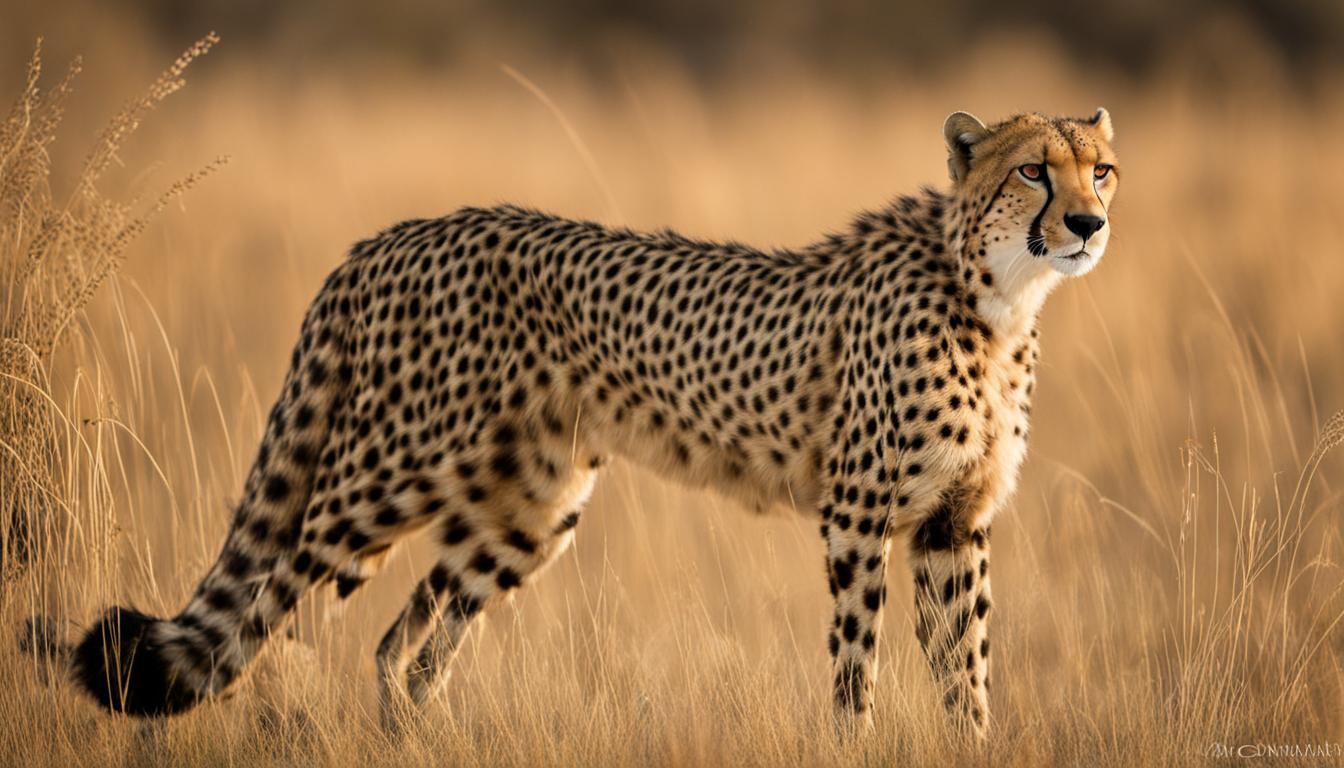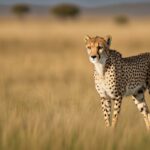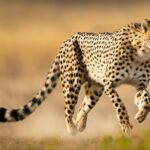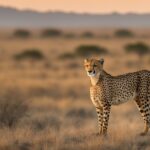Cheetahs are known for their incredible speed and agility, but what physical adaptations have enabled them to thrive in their habitats? Let’s explore the fascinating cheetah adaptations, including their physical and habitat-specific traits.
From their small, lightweight bodies to their long leg and foot bones, cheetahs possess a variety of physical adaptations that contribute to their exceptional speed and agility. These adaptations allow them to achieve rapid acceleration, making them the fastest land animals on Earth.
Furthermore, cheetahs have flexible spines and spring-like ligaments in their legs, providing them with remarkable endurance during high-speed pursuits. Their enlarged hearts, oversized livers, and large arteries are specifically adapted to support their intense bursts of speed, ensuring a constant supply of oxygen to their muscles.
In terms of habitat adaptations, cheetahs have evolved to thrive in wide, open areas such as grasslands and savannahs. Their light-colored coats with black spots provide camouflage, allowing them to blend into their surroundings while lying in tall grass or perched in trees. These adaptations enable cheetahs to effectively hunt their prey and evade potential threats.
However, despite their impressive adaptations, cheetahs face numerous challenges, including habitat loss and poaching. Conservation efforts are crucial to protecting these magnificent creatures and ensuring their survival for future generations.
Stay tuned as we delve deeper into the specific adaptations that make cheetahs one of nature’s most remarkable predators.
Adaptations for Speed
Cheetahs are renowned for their incredible speed, and their adaptations for speed play a crucial role in their hunting and survival. These magnificent big cats have evolved physical traits that allow them to reach astonishing velocities in pursuit of their prey.
One of the key adaptations for speed is their lightweight skeleton and long legs. This combination enables cheetahs to achieve rapid acceleration and cover long distances with each stride. Their enlarged heart and lungs, along with an extensive respiratory system, provide the necessary oxygen intake during high-speed sprints. Additionally, cheetahs possess a higher concentration of “fast twitch” muscle fibers, which allow for short bursts of power when needed.
“Cheetahs are true masters of speed,” says Dr. Jane Wilson, a wildlife biologist. “Their adaptations, such as their lightweight build and efficient respiratory system, enable them to excel in chasing down their prey with incredible agility.”
Comparative Table: Adaptations for Speed
| Adaptation | Function |
|---|---|
| Lightweight Skeleton and Long Legs | Enable rapid acceleration and long strides |
| Enlarged Heart and Lungs | Provide increased oxygen intake during sprints |
| “Fast Twitch” Muscle Fibers | Allow for short bursts of power |
The cheetah’s adaptations for speed not only make them formidable hunters but also help them to survive in their challenging environments. Their ability to reach incredible velocities is a testament to their remarkable adaptations and their place as one of nature’s most extraordinary creatures.
Stay tuned for the next section, where we explore the fascinating adaptations cheetahs possess for hunting.
Adaptations for Hunting
Cheetahs have developed specialized adaptations that aid their hunting techniques. These unique adaptations, both behavioral and physiological, allow them to effectively locate, track, and capture their prey. Let’s explore some of the remarkable adaptations cheetahs have evolved for successful hunting.
Marks of a Predator
Cheetahs possess distinct physical features that enhance their hunting abilities. The black tear markings under their eyes serve a dual purpose. Not only do these marks reduce glare from the sun, but they also help improve focus on the target without compromising their vision. Additionally, cheetahs have a small, flat face with large eyes positioned for maximum binocular vision. This exceptional eyesight enables them to spot and track fast-moving prey with precision.
Paws and Claws
The structure of a cheetah’s paws is another crucial adaptation for hunting. Their paws are narrower than those of other large felines, resembling the shape of a dog’s paw. This design provides cheetahs with increased grip and traction while pursuing prey at high speeds. Furthermore, their claws, although only semi-retractable compared to other big cats, offer extra traction and stability during sharp turns and quick maneuvers. These sharp claws are essential for maintaining balance and changing direction swiftly.
The Perfect Tail
Cheetahs’ long tails play a vital role in their hunting strategies. Acting as a counterbalance during sharp turns, the cheetah’s tail helps guide its direction while maintaining stability and preventing over-rotation. This agility allows them to navigate seamlessly through complex terrains and keep up with their fast-moving prey during high-speed chases. The length and flexibility of their tails give cheetahs an edge in making quick, precise movements during pursuit.
| Adaptation | Description |
|---|---|
| Tear markings | Reduces glare and enhances focus during hunts |
| Binocular vision | Large eyes provide maximum depth perception and tracking ability |
| Narrow paws | Enhanced grip and traction for high-speed pursuits |
| Sharp claws | Extra traction and stability during sharp turns and maneuvers |
| Long tail | Acts as a counterbalance and provides agility during chases |
Environmental Adaptations
Cheetahs have evolved remarkable adaptations that enable them to thrive in their specific environments. These adaptations not only contribute to their survival but also enhance their chances of successfully hunting prey. One notable environmental adaptation of cheetahs is their light-colored coat with black spots, which provides excellent camouflage while they lie in tall grass or perch in trees. This allows them to blend seamlessly into their surroundings, making it easier for them to approach their prey undetected.
Cheetahs also have tear markings on their faces, which serve a functional purpose in their open plains habitat. These tear markings help reduce sun glare, enabling cheetahs to maintain focus on their surroundings and potential prey. Additionally, cheetahs have adapted to wide, open areas such as the savannah, where their exceptional sight and maneuverability give them an advantage in hunting fast, agile prey.
It is important to note that cheetahs are not well-suited for forested habitats due to their specific adaptations for open environments. In dense forests, their speed and agility may be hindered by obstacles such as trees and dense vegetation. Therefore, their adaptations have uniquely shaped them to excel in the grasslands and open plains, where their hunting strategies and physical attributes are most effective.

Table: Cheetah Environmental Adaptations
| Adaptation | Description |
|---|---|
| Light-colored coat with black spots | Provides camouflage in tall grass and trees |
| Tear markings on the face | Reduces sun glare on open plains |
| Wide, open habitat preference | Allows for excellent sight and maneuverability |
| Not well-suited for forested habitats | Adaptations optimized for open environments |
In summary, cheetahs have adapted specific traits to thrive in their environments. Their light-colored coat, tear markings, and preference for open habitats contribute to their successful hunting strategies and camouflage. These environmental adaptations have played a crucial role in the survival and evolution of cheetahs as formidable predators.
Threats and Conservation of Cheetahs
Cheetahs, despite their remarkable adaptations, face numerous threats that jeopardize their survival. Human activities, such as habitat destruction and poaching, have resulted in a significant decline in cheetah populations. The encroachment of thorn bushes in their grasslands has also become a major threat, causing injuries during high-speed sprints. These challenges have led to the classification of cheetahs as a vulnerable species by the International Union for Conservation of Nature (IUCN).

Efforts to conserve cheetahs and protect their habitats are crucial to ensure their long-term survival. Conservation initiatives focus on various strategies, including creating protected areas, implementing anti-poaching measures, and promoting sustainable land use practices. Collaborative efforts between governments, conservation organizations, and local communities are essential to achieve effective conservation outcomes.
Threats to Cheetahs
One of the primary threats to cheetah survival is human encroachment on their habitats. As human populations expand and agricultural activities intensify, cheetahs lose their natural habitat and are forced into fragmented landscapes. This habitat loss disrupts their ability to find prey, establish territories, and reproduce successfully.
| Threats | Impact |
|---|---|
| Habitat destruction | Loss of suitable living space and reduced prey availability |
| Poaching and illegal wildlife trade | Decline in cheetah numbers due to demand for their skins and body parts |
| Human-wildlife conflict | Retaliatory killings by farmers protecting livestock |
Additionally, the illegal wildlife trade poses a significant threat to cheetahs. Cheetahs are hunted for their skins, which are highly valued in the fashion industry, and their body parts, which are used in traditional medicine. The demand for these products further drives the decline of cheetah populations.
To address these threats, conservation organizations work to raise awareness about the importance of cheetah conservation and the need for sustainable livelihoods for local communities. By promoting coexistence between humans and cheetahs, implementing anti-poaching measures, and supporting alternative income-generating activities, conservation efforts aim to protect cheetahs and their habitats for future generations.
Conclusion
Cheetahs have evolved remarkable physical, behavioral, and physiological adaptations that enable them to thrive in their environments. Their adaptations for speed, hunting, and survival make them highly successful predators on the African savannah. Their small, lightweight bodies, long legs, and flexible spines allow them to achieve rapid acceleration and maintain endurance during high-speed pursuits.
Furthermore, cheetahs possess specialized respiratory systems with enlarged nostrils and extensive sinuses that enable them to intake more oxygen while running. Their enlarged heart, oversized liver, and large arteries support their high-speed pursuits. These physical adaptations, alongside their behavioral traits such as tear markings for reduced glare and precise vision, narrow paws for extra traction, and a long tail for balance during sharp turns, make cheetahs formidable hunters.
However, despite their incredible adaptations, cheetahs face significant threats to their existence due to human activities. Human encroachment, habitat loss, and poaching have led to a drastic decline in cheetah populations. Additionally, the encroachment of thorn bushes in their grasslands poses a danger to their sprinting capabilities. It is crucial to create awareness and take proactive measures to protect and conserve cheetah populations, ensuring the preservation of their evolutionary adaptations and the biodiversity of their habitats.
Do the Adaptations of Cheetahs Help Them Survive in Changing Environments Due to Climate Change?
The adaptations of cheetahs and climate change have been crucial for their survival. Their incredible speed and agility help them capture prey in changing environments. However, climate change poses new challenges, such as food scarcity and increased competition. Cheetahs must continue to adapt to ensure their survival in the face of these environmental changes.
FAQ
How have cheetahs adapted to their environments?
Cheetahs have adapted various physical, behavioral, and physiological traits to thrive in their environments.
What are the adaptations for speed in cheetahs?
Cheetahs have lightweight skeletons, long legs, and an enlarged heart and lungs to support their high-speed pursuits.
What are the adaptations for hunting in cheetahs?
Cheetahs have tear markings to reduce glare, binocular vision for tracking, and specialized paws and claws for effective pursuit of prey.
What are the environmental adaptations of cheetahs?
Cheetahs have light-colored coats for camouflage and are adapted to wide, open areas for hunting.
What threats do cheetahs face, and what conservation efforts are being made?
Human encroachment, habitat loss, and poaching pose significant threats to cheetahs. Conservation efforts are crucial to protect and preserve their populations.










